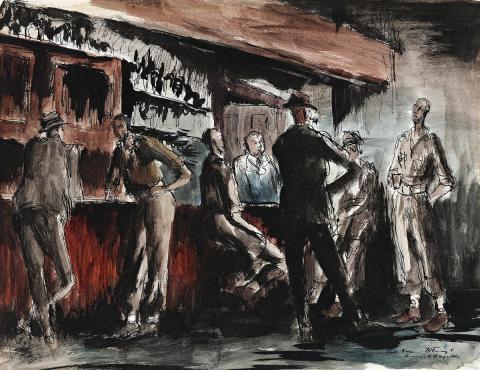THE BAR – ALBURY, c.1942 – 43
RUSSELL DRYSDALE
pen and ink and watercolour on paper
29.5 x 39.5 cm
signed and inscribed with title lower right: The Bar – Albury / Russell Drysdale
Rupert A. Henderson, Sydney, acquired directly from the artist
Thence by descent
Mrs R. A. Henderson, Sydney
The Estate of the late James O. Fairfax AC, New South Wales, acquired from the above in 1987
Russell Drysdale’s images of Australia and its inhabitants helped define our national identity, capturing the essence of the country and the character of its people. One of the best-known artists of his generation, Drysdale’s art is on permanent display in major galleries throughout the country and he remains a household name. Drysdale is also one of a small handful of twentieth century Australian artists to have achieved significant international recognition during his lifetime. His work was acquired by New York’s Metropolitan Museum of Art in 1941 and is also represented in the Tate, London, and major private collections including that of Her Majesty Queen Elizabeth II. In 1954, he was selected alongside Sidney Nolan and William Dobell to represent Australia at the XXVII Venice Biennale – the first time Australia had participated in this pre-eminent international exhibition of contemporary art – and in 1969, his contribution to Australian art was recognised with a knighthood.
Prompted by the frightening prospect of invasion following the detection of a Japanese submarine in Sydney Harbour in 1942, Drysdale and his family moved to Albury where they rented a house and he established a studio in a nearby barn. The reality of war was ever-present however, with army camps located nearby and soldiers frequently seen marching along the road, congregating in town and waiting at the railway station.1 Rejected from military service due to impaired eyesight, Drysdale wanted to do his bit and was advised to continue painting and ‘helping to record for posterity the feeling and fabric of the time’.2 The paintings and drawings he made in the early 1940s do just that and in effect, constitute the personal effort of an unofficial war artist who recorded the experience of life at home during wartime from a rural perspective.3
It is the presence of two soldiers drinking with their civilian friends in The Bar – Albury, c.1942-43 that links this drawing to the series of major paintings and works on paper that emerged from Drysdale’s experience in Albury, including The Station Yard, 1943 (National Gallery of Victoria) and Albury Platform, 1943 (Albury Regional Art Centre). Drysdale was a gifted draughtsman who once said that ‘drawing is as essential to an artist as practising scales to a pianist’4 and his facility is clear in this work where the figures and details of the interior are defined by quick but assured pen and ink lines, volume is added with a brush and black ink and finally, subdued tones of watercolour activate the composition. Both the setting and the relaxed camaraderie of the laconic figures make this a classic Drysdale depiction of Australian country life that is at once familiar and, almost eighty years on, also tinged with a sense of nostalgia.
1. Klepac, L., Russell Drysdale, Murdoch Books, Sydney, 2009, p. 85
2. ibid., p. 95
3. Smith, G., Russell Drysdale 1912-81, exhibition catalogue, National Gallery of Victoria, Melbourne, 1997, p. 21
4. Drysdale, R., quoted in Klepac, L., The Drawings of Russell Drysdale, exhibition catalogue, Art Gallery of Western Australia and The Australian Gallery Directors’ Council, Perth, 1980, p. 36
KIRSTY GRANT
Former Director of Heide Museum of Modern Art
Former Senior Curator, National Gallery of Victoria
